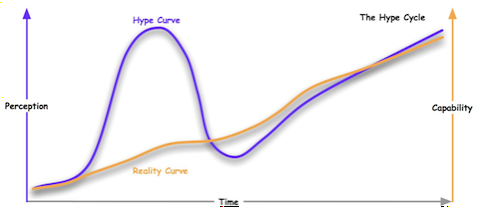Here’s a little history: in the early nineties, much of my consultancy work orbited (often eccentrically) around a binary model: the development of new technologies and helping clients to understand how those technologies could help their businesses and to work out how and when to jump in. It still does.
To complement my arm-waving, I devised a simple model to help demonstrate and explain the accelerating curve of hype, bubble, bust and disillusion that typically accompanies the development of new technologies and services. With tongue only slightly in cheek, I called this the Hype Cycle, and it’s proved a useful way of helping people understand the interplay between capability and perception in investment, marketing and strategic decision-making.
This isn’t the place for a detailed description of the Hype Cycle, but suffice it to say that, at its most basic, it comprises two curves: the Hype Curve & the Reality Curve. The Hype Curve shows the market perception of a product or service over time, as it ramps up to a bubble of of market and media hype, slides into disillusion and retrenchment as the hype fails to match delivered capability and, if it survives, perception and capability align to generate sustainable growth.
The Reality Curve shows the development of measurable capability and benefit over time – accelerating somewhat as the growth of perception generates additional investment, and slowing as post-crash disillusion reduces available resources, before ramping up again as perception and capability align, often driven by the convergent maturation of multiple complementary technologies. When the capability of the Reality Curve rises above the perception of the Hype Curve, we’re into that “gap into reality” where a a product or service is effectively under-valued in the marketplace – a typical post-crash situation.
I developed this model in 1992/1993, while working on the beta program for the Apple Newton and consulting on the likely impact of the public Internet. And rather helpful it proved too – one or two intersecting curves that could be trivially sketched on a lunchtime napkin. Which is exactly what I did at Fourth International World Wide Web Conference in Boston in December 1995 – drawing the basic Hype Curve for the benefit of a table full of analysts and consultants with whom I was having lunch. And thought no more of it.
It was some years later that I came across the Gartner Group’s version of the Hype Cycle, which could best be described as an “interesting” experience. Now fast forward to last week, and the very good talk I went to at the LSE on Synthetic Biology. In his presentation, Professor Chris Mason used the Hype Cycle to illustrate his excellent talk on the rise of technology driven by Genomics. So, with the model becoming ubiquitous in its application, I thought it time to add my not uninterested contribution to the public record.
So let’s consider two possibilities: firstly, that the Hype Cycle was an idea whose time had come, where demand stimulated parallel and independent exercises in imagination. I’m happy to accept that that may indeed be the case. The other possibility may be considered a tad less generous. Now I’d always intended this to be a model for the public domain – in matters such as this, I regard the currency of knowledge to be attribution. Right now however, I’m feeling a little short changed.

